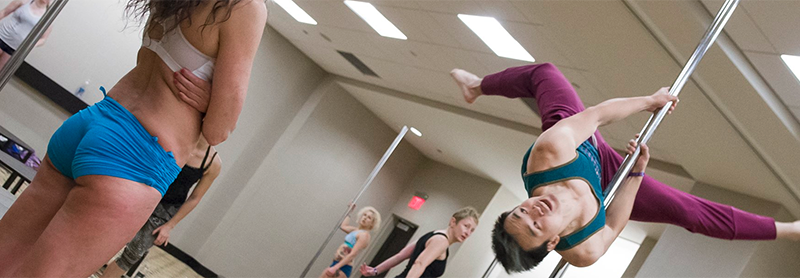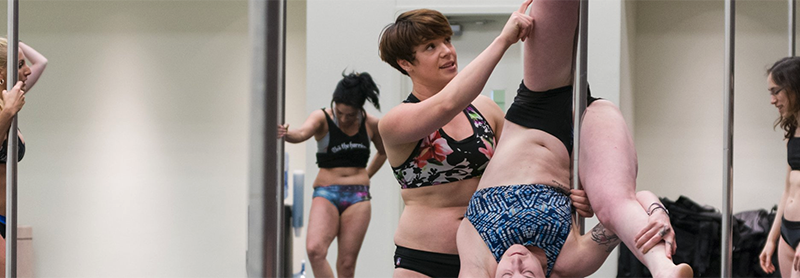There are several reasons people start pole dancing as a hobby. Some are looking for…

How to Pick the Right Poles for Your Pole-based Business
Selecting the right poles for your pole-based business is a fairly straightforward process. There are a handful of companies manufacturing freestanding and mounted poles currently with more manufacturers entering the market world-wide each year.
Determine your studio needs
How you plan to deliver your pole-related services will help you determine your pole needs. Determining your individual pole needs will help you make the final decision of which manufacturer to use as not all manufactures offer the same features in their pole models.
The first step is to identify whether you will have a regular pole teaching space such as a studio or if you need a more portable pole solution such as if you are conducting mobile pole parties or performing in different locations.
Determine your available ceiling height
Available ceiling height in any space you intend to teach, perform or otherwise us your pole will dictate how tall your poles can be. If your pole teaching space is going to be used for other aerial arts or performances you will likely need to remove poles semi-regularly. If your ceiling height is too high, which can be the case for other aerials like silks, you may need to install a truss or other structure to install your poles on. The desire for or requirement of having removable versus permanent mounts at the ceiling for your poles will also impact which manufacturer you choose.
If you intend to move your pole around, you are likely to want a pole that puts the least impact on any structure and is completely removable and easy to carry.
Space needs can also influence if you choose to install multi-piece or single-piece poles. If you are just starting out and know that you would like to move spaces in the future, then a multi-piece pole will give you more flexibility should the height of the ceiling in your new space be different then the current space. Conversely, if you know you will be in one space for several years, having a single-piece pole designed specifically for your space can offer a lower maintenance alternative.
Always make sure to measure the ceiling height of any space you intend to rent for your pole needs. Commercial landlords and other rental agencies do not always have accurate ceiling height measurements.
Pick your pole finish
Once height, style of mount and basic pole construction have been decided, then you’ll need to select pole diameter and finish.
The studio and competition segments of the pole industry have begun to standardize on diameter and finish, although there is still no “official” standard. In North America the standard is predominantly 45mm chrome poles that offer both spin and static options. Whereas in Australia brass finishes and smaller diameters such as 40mm or even 38mm are preferred. Strip clubs may have a range of finishes and sizes as large as 50mm and not all poles spin.
Some manufacturers offer powder-coated poles that are not suitable for static spins and are less common in competitions or studio environments.
Keep in mind when selecting a finish that some students may have allergic reactions to different metal finishes. If you have chrome finish poles, the nickel content underneath the chrome (which appears when chrome is worn or chipped away such as due to jewelry contact) may cause some students to have a reaction. You may want a mix of finishes to support dancers with allergies.
Make sure you choose a finish and size that is commonly accepted in your area, particularly if you intend to perform or teach in the studio and competition segments of the pole industry. If you intend on working in the club segment, being versatile on many finishes and sizes is preferred.
Find the right manufacturer
Ceiling height, mount preference, diameter and finish will help you identify your preferred manufacturer. Be cautious of mixing and matching pole manufacturers as well as pole makes and models as more types of poles may make long term maintenance more difficult since you may need different different tools and a variety of spare parts to service them.
Not all manufacturers offer the same features in their poles. When you are ready to purchase your identified pole, contact the manufacturer directly, don’t just log into the website and order 10 poles. Most manufacturers offer studio or other wholesale discounts, and can provide a quote on your individual project needs. Additionally the manufacturer may offer an affiliate or dealer program which your studio can use to make passive income, or earn funds toward future purchases. If all goes well, you will make future purchases with that particular manufacturer so it’s good to start a relationship early.
X-POLE, who has provided poles in our industry for more than 10 years, is a partner of the IPIA and offers a 20% discount off all equipment including poles. Join today to access your discount.
Installing and maintaining your poles
Create a tool kit
Depending on your pole make and model, you will also need to assemble a studio tool set. If your poles use a screw or pin to change from spin to static mode then having extra screws and pins on hand will help keep your poles functioning in tip top condition. Likewise, having the tools to install the screws or pins is also essential. More than one allen wrench or other necessary tools is recommended. Your pole tool box should also include a magnetic level especially for removable poles.
Get your poles professionally installed
In most cases the initial installation of your studio or club poles should be done by a professional. There are professional aerial riggers who can install your equipment safely. If working with a professional rigger is not an option, at a minimum, work with a general contractor or handyman who can review factory specifications from the manufacturer on how to install your poles safely and ensure they are secured and on a stud in your ceiling.
Observe the pole installation process to understand how your poles are meant to function and what parts, pieces, and tools you’ll need in your pole space to keep your poles safe and operational in the long run.
Check and maintain your poles
Poles can loosen over time. Make sure you regularly (such as monthly or quarterly depending on how much wear they receive) check your poles to confirm they are still securely installed. Permanent mounted poles will shift less than tension mounted poles. Beware of over-tightening your poles as this can crush the bearings in poles that switch between static and spin moes. Watch out for pieces of poles shifting in multi-piece poles and always realign before the twist becomes too severe. Also watch out for metal “lips” that may form between pieces in multi-piece poles. The finish on poles may wear from use and from jewelry scratches. Consider making a “no jewelry” policy for anyone who will use your poles to maintain the finish as long as possible. Make sure your poles are cleaned after every use. In extreme cases, and mostly in very tall poles, the pole may bend from pressure. Make sure all poles are straight.
Replacing your poles
No matter how well you maintain your poles, at some point they will need to be replaced. If you have multi-piece poles you may only need to replace portions of the pole at a time, whereas if something goes wrong with a single-piece pole then you will likely be replacing the whole pole.
Budget for recapitalizing your studio hardware is essential to keeping your studio functioning. If and when you end up with a damaged pole then you will need the funds to replace the non-functioning equipment. If you do not have the funds on hand, you will need to take the unsafe equipment out of use potentially resulting in smaller class size and limiting earn potential.
Next steps
Understand your unique needs and preferences. Do your research. Contact manufacturers and ask questions! Your pole space can provide unique challenges; get answers to your questions before you buy. After any rental space, your poles are your major operating equipment and key to your long term success.



